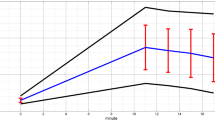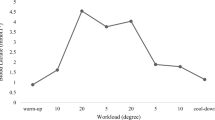Abstract
We examined the effect in ten male sports students of 30-min resistance exercise followed by either 45-min regeneration with massage treatment on a massage bench or supine rest serving as control, on plasma catecholamine concentration, number and distribution of circulating white blood cells and central activitity. Resistance exercise increased free plasma adrenaline (A) and noradrenaline (NA), whereas sulpho-conjugated catecholamine concentration remained unchanged as determined by high performance liquid chromatography. Exercise induced leucocytosis and lymphocytosis measured by flow cytometry was predominantly manifested by an increase in the number of lymphocytes, monocytes, CD3+ cells, CD8+ cells and CD3− CD16/56+ cells. Computer-aided electroencephalography (EEG) revealed significant increases in absolute EEG band power. The increase was highest in alpha 2 with 51.6 (SD 40.2) % (P<0.01), followed by beta 1 with 33.3 (SD 21.0) % (P<0.01), alpha 1 with 31.9 (SD 25.2) % (P<0.01), beta 2 with 30.8 (SD 26.7) % (P<0.01), delta with 26.1 (SD 28.7) % (P<0.05), and theta with 19.8 (SD 16.5) % (P<0.01). All hormone and immunological variables returned to pre-exercise values 45 min after exercise with no differences between massage and control treatments. However, during regeneration differences in absolute EEG-band power were observed between massage and control treatments. In central (Cz, C3, C4) and fronto-lateral (F3, F4) electrode positions absolute beta 1 spectral power density was significantly lower during massage treatment than during control (Wilcoxon test:P<0.01). Overall, these data demonstrated that an influence of massage treatment on deactivation characteristics could be observed in EEG measurements but not in plasma catecholamine concentration or blood lymphocytes, indicating that computer-aided topographical EEG may be a useful technique for studying activation and regeneration characteristics.
Similar content being viewed by others
References
Beaumont G, Kenealy, PM (1992) Topographical EEG evidence for frontal attention system in visual semantic processing. J Psychophysiol 6:85
Beyer L, Weiss T, Hansen E, Rost R (1988) Die EEG-Grundaktivität — Parameter zentraler Aktivierung der Handlungsregulation bei Ringern. Dtsch Z Sport Med 44:294–299
Blom JL, Anneveldt M (1982) An electrode cap tested. Electroencephalogr Clin Neurophysiol 54:991–594
Bulbulia R, Darabos B, Nauta S (1987) Supine rest and lactic acid removal following maximal exercise. J Sports Med Phys Fitness 27(2):151–156
Drischel H, Dettmar P (1972) Einige biokybernetische Aspekte des zentralen Effekts von Adrenalin. Biocybernetics 4:166–170
Fry RW, Morton AR, Crawford GPM, Keast D (1992) Cell numbers and in vitro responses of leucocytes and lymphocyte subpopulation following maximal exercise and interval training sessions of different intensities. Eur J Appl Physiol 64:218–227
Gabriel H, Schwarz L, Steffens G, Kindermann W (1992a) Immunoregulatory hormones, circulating leucocyte and lymphocyte subpopulations before and after endurance exercise of different intensities. Int J Sports Med 13:359–366
Gabriel H, Urhausen A, Kindermann W (1992b) Mobilization of circulating leucocyte and lymphocyte subpopulations during and after short, anaerobic exercise. Eur J Appl Physiol 65:164–170
Galbo H (1981) Endocrinology and metabolism in exercise. Int J Sports Med 2:203–211
Jähnig P, Jobert M (1995) Methodological considerations for the evaluation of EEG mapping data: a practical example based on a placebo/diacepam crossover trial. Neuropsychobiology 31:31–46
Jasper HH (1958) The ten-twenty electrode system of the International Federation. Electroencephalogr Clin Neurophysiol 10:371–375
Krause G, Ullsberger P, Beyer L, Gille HG (1983) Changes in EEG-Power density spectrum during static muscle work. Eur J Appl Physiol 51:61–66
Litschka-Schimpf G, Manzl G, Schimpf A, Weiß M, Eberspächer H, Weicker H (1988) Influence of different experimental recreation treatments on sympatho-adrenergic and metabolic regulation mechanisms in repeated exercises. Int J Sports Med [Suppl] 146–150
Maisel AS, Harris T, Rearden CA, Michel MC (1990)β-Adrener-gic receptors in lymphocyte subsets after exercise. Circulation 82:2003–2010
Meyer R, Mayer U, Weiß M, Weicker H (1988) Sympathoadrenergic regulation of metabolism and cardiocirculation during and following running exercises of different intensity and duration. Int J Sports Med 9:132–140
Nishihira Y, Araki H, Ishihara A (1989) Cerebral motor potential preceding grip strength movement. J Sport Med Phys Fitness 29:297–303
Pluto R, Cruze SA, Weiß M, Hotz T, Mandel P, Weicker H (1988) Cardiocirculatory, hormonal, and metabolic reactions to various forms of ergometric tests. Int J Sports Med 9:79–88
Roßkopf P, Große-Scharmann H, Hundtke HW, Liesen H, Weiß M (1994) Vergleichende Untersuchung der freien und sulfatierten Katecholamine nach Krafttraining und im Regenerationsverlauf. In: Liesen H, Weiß M, Baum M (eds) Regulations- and Repairmechanismen. Deutscher Ärzteverlag, Cologne
Schwarz-Ottersbach E, Goldberg L (1986) Activation levels, EEG, and behavioral responses. Int J Psychophysiol 4:1–17
Strobl G, Hack V, Kinscherf R, Weicker H (1993) Sustained noradrenaline sulphate response in long-distance runners and untrained subjects up to 2 h after exhausting exercise. Eur J Appl Physiol 66:421–426
Weicker H (1988) Determination of free and sulfoconjugated catecholamines in plasma and urine by high-performance liquid chromatography. Int J Sports Med 9:68–74
Weigent DA, Carr DJJ, Blalock JE (1990) Bidirectional communication between neuroendocrine and immune systems. Ann NY Acad Sci 579:17–27
Werle E, Jost J, Koglin J, Weiß M, Weicker H (1989) Modulation der zellulären Immunabwehr auf Rezeptorebene während akuter körperlicher Belastung. Dtsch Z Sport Med 40:14–22
Author information
Authors and Affiliations
Rights and permissions
About this article
Cite this article
Stock, C., Baum, M., Roßkopf, P. et al. Electroencephalogram activity, catecholamines, and lymphocyte subpopulations after resistance exercise and during regeneration. Europ. J. Appl. Physiol. 72, 235–241 (1996). https://doi.org/10.1007/BF00838645
Accepted:
Issue Date:
DOI: https://doi.org/10.1007/BF00838645




